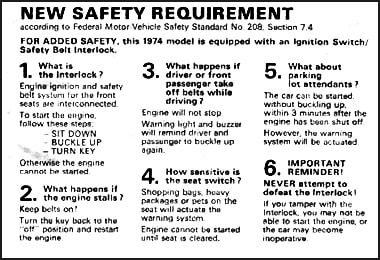I'm not talking about things that didn't work WELL. I'm talking about things they thought they had all worked out but they had to STOP in a year or two.
I'm thinking about the Great 1974 Seatbelt Interlock Debacle. It could have worked IF they had the driver side so the car wouldn't do anything without the seatbelt buckled. That of course would have pissed off mechanics, not a good group to piss off. So many people bypassed the seat switches, hacked the retractor sensors or just sat on the buckled seatbelt I doubt ANY cars had functioning systems by 1976. The Feds and Detroit backed off until airbags and passive belts. America was safe to carry bags of groceries unbuckled in the passenger seat again.
I'm thinking about the Great 1974 Seatbelt Interlock Debacle. It could have worked IF they had the driver side so the car wouldn't do anything without the seatbelt buckled. That of course would have pissed off mechanics, not a good group to piss off. So many people bypassed the seat switches, hacked the retractor sensors or just sat on the buckled seatbelt I doubt ANY cars had functioning systems by 1976. The Feds and Detroit backed off until airbags and passive belts. America was safe to carry bags of groceries unbuckled in the passenger seat again.


 . had to remove the exhaust manifold and half the exhaust system to get to these bolts.
. had to remove the exhaust manifold and half the exhaust system to get to these bolts.


Comment